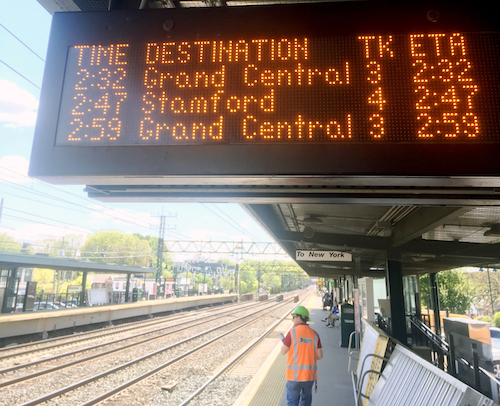It’s Monday morning, and you’re running late for your early train to the city. You break a sweat sprinting for the platform, but you look up and relax. A large overhead electronic sign tells you you’ve made it with a few minutes to spare.

|
| New York Local 859 member Bill McVinua inspects a newly placed overhead message sign at Metro-North’s Mamaroneck Station.
|
For Metro-North commuters, new signage providing critical real-time information is helping to ease the stress of travel, and it’s thanks to the hard work of IBEW electricians from New York-area railroad locals.
“The [Metropolitan Transportation Authority] used to have these hard-wired signs that didn’t provide a lot of information,” said New York Local 859 President and Business Manager John Gallagher. “Oftentimes, it was only the date or that trains were in good service.”
Through the first half of 2019, Local 859 members — along with members of New York Local 817 and New Haven, Conn., Local 747 — removed the outdated variable message signs at dozens of stations serving the various Metro-North lines.
The new, modernized signs use bright gold LEDs to display a wealth of useful information, such as the scheduled and actual arrival times of the station’s next three trains, plus those trains’ destinations and designated arrival track.
The signs receive their display data wirelessly, thanks to hardware also expertly installed by IBEW members.
“They might not have a formal Code of Excellence agreement in place, but you can see how the Code’s values have an influence on how our members get the job done for the MTA,” said Railroad Department Director William Bohné. “Their work is helping tens of thousands of transit riders get into Manhattan safely and efficiently every day of the week.”
The upgraded signs provide those commuters with clear access to reliable and often crucial Metro-North train schedule information on rail platforms and in station lobbies, Bohné said.
“This upgrade was long overdue,” said Gallagher, noting that it was just one component of the MTA’s $56 million “Way Ahead” plan to modernize the Metro-North railroad’s facilities as well as its security and customer service systems.
Some of Metro-North’s tracks and stations can trace their origins back to the late 1800s; in 1983, the MTA created Metro-North out of the former Conrail system.
For residents of some of New York City’s far-flung suburbs, access to convenient and reliable rail travel often means the difference between sitting and relaxing on a train trip to Manhattan versus clenching a steering wheel and fighting your way to and through New York City’s famous gridlock.
In 2017, Metro-North carried a record 86.5 million customers. Keeping this massive volume of paying customers happy — and loyal — was obviously critical for the MTA, and the agency knew it could count on the IBEW to quickly and efficiently get the 21st century signage installed. The agency turned out to be correct, of course: These union electricians finished the upgrades within six months.
“We were able to fit it in with our other work,” said Gallagher, who noted the team maintains station public address systems, too. “We work out of the radio shop, so we work on all of that stuff.”
Going forward, IBEW members will continue to maintain the signs, keeping a closer eye on the ones installed outdoors that are vulnerable to damage from vandalism and exposure to the northeastern U.S.’s brutal winters.
So far, rail customers seem pleased with the results of the work, Gallagher said. “They’re getting a lot more relevant information than before,” he said. “When they’re not happy, they’re not afraid to say so.”